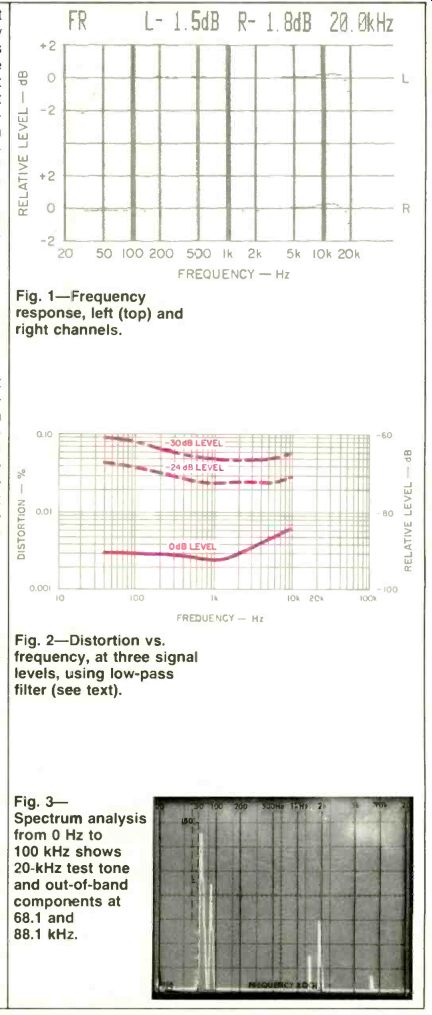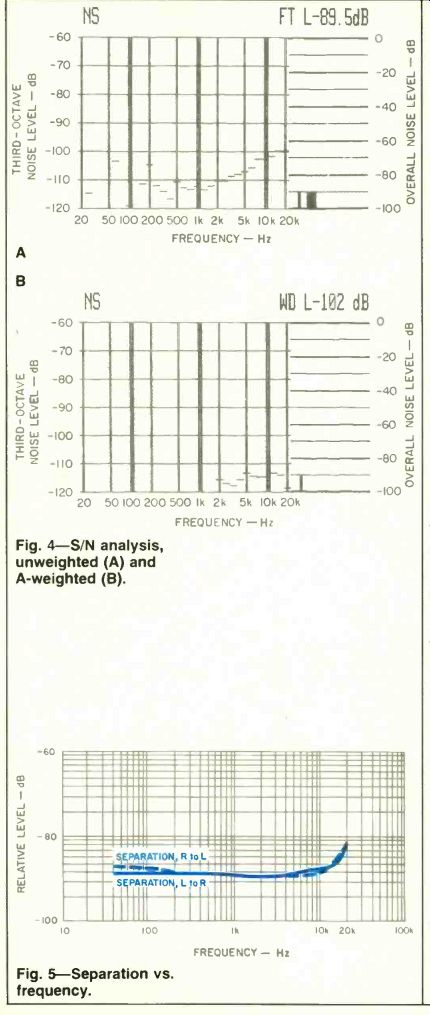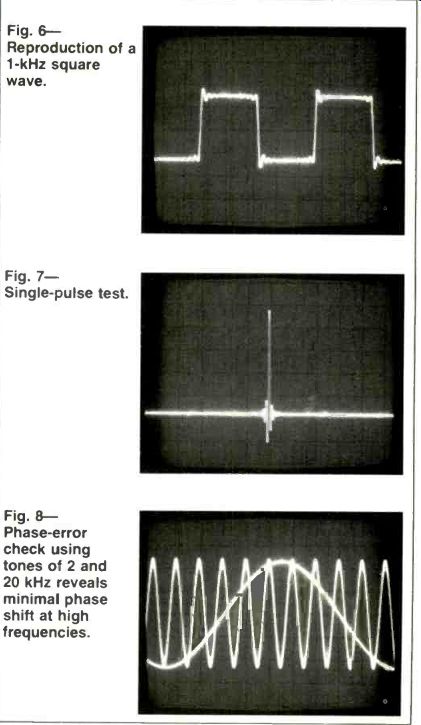Manufacturer's Specifications
Chipset; and CD mech: PCM53JP-V, YM2601; MLP-2A
Frequency Response: 3 Hz to 20 kHz, +0.5,-1.0 dB.
THD + Noise: 0.004%.
Dynamic Range: 96 dB.
S/N Ratio: 100 dB, A-weighted.
Number of Programmable Selections: 9.
Channel Separation: 90 dB.
Line Output Level: 2.0 V
Headphone Output Level: 0.16 V at-20 dB (8 ohms).
Power Requirements: 120 V, 60 Hz, 20 watts.
Dimensions: 17 1/4 in. W x 3- 11/16 in. H x 11- 7/16 in. D (43.5 cm x 9.4 cm x 29.1 cm).
Weight: 9 lbs., 11 oz. (4.4 kg).
Price: $499.
Company Address: P.O. Box 6600. Buena Park, Cal. 90620.

Yamaha has consistently been at the forefront of Compact Disc technology and product development. I recall how impressed I was with their first CD player, the CD-1. It was practically hand-built and so costly to produce that, despite its steep selling price, the company insists to this day that they actually lost money on each sale. If so, the investment certainly paid off, for Yamaha's second- and third-generation players continue to represent state-of-the-art design and performance. The current entry, the Model CD-3, em ploys a set of large-scale integrated circuits developed and produced by Yamaha. The circuitry employs digital filtering at 2x or 88.2-khz oversampling, as did earlier Yamaha players.
Access to specific tracks or index points is now faster than before, and you can program up to nine items for playback in true random order. Admittedly, this number of programmable items falls short of the number found on some competitive units, but I suspect Yamaha has limited the programmability to a practical and economical number (how often will you really need to program more than nine items on any one disc?) and applied the money it saved to such things as faster access, excellent tracking stability, and, most important of all, superb sound reproduction.
The CD-3 is equipped with a wireless remote control that duplicates just about every function of the main unit, including random-access programming. The remote control even includes buttons for opening and closing the disc compartment (presumably to speed disc installation in the tray) and for sequentially altering the information illuminates on the CD-3's front-panel display. Because the remote module does not have a number keypad (the main panel doesn't have one, either), you may at first doubt that it could be used for programming. But it is possible, thanks to the clever and simple way in which programming is accomplished on the CD-3. More on that in a moment.
Control Layout
The slide-out disc tray and "Power" pushbutton of the CD-3 are located at the left of the front panel. Just to the tray's right is an elaborate, multi-function display. It shows track number, elapsed time, total disc time (in stop mode only), index number, activation of the repeat-play function (including activation of the A-to-B musical-phrase-repeat feature, which plays and replays the music between any two user-defined points on the disc), and even confirmation (by a light) that remote-control commands have been received and registered. An "Open/Close" key for operating the disc tray and a key which alters the display mode are further to the right; below these keys, and also to their right, are the controls used for play and programming.
The controls used for play include large "Play" and "Pause/Stop" buttons as well as smaller, paired buttons which shift the laser ahead or back to desired locations on the disc: " + " and "- " buttons step the laser between track beginnings, while the buttons marked with forward and reverse double arrows move it to any point on the d sc. The double-arrow search functions are silent if undertaken from pause mode, but audible (at about one-fourth normal volume) if undertaken from play mode. The search function begins at a moderate speed, then speeds up if the button is held down more than 3 S.
The double-arrow keys are also used for access to indexed portions of long disc tracks. After the track number is set with the " +" or "-" key, the forward double-arrow key is pressed one or more times to get the desired index number--e.g., three times for index number 3. The display then shows the selection and index numbers, and an "Index" light beneath the numerical display illuminates. Index ac cess is available only in non-programmed play.
Four keys are only involved in programming and repeat play: "Set/Check" and "Clear" for programming, "On/Off" and A-to-B for repeat functions. To program selections, you merely press the "Set/Check" program button, advance or retreat the displayed track number via the " + " or "- " button, and then press "Set/Check" again, to memorize the desired track number. ("Clear" erases the program, as does opening the disc drawer.) The display shows which pro gram number you are setting and which track you are setting it to. During programmed playback, the display repeats this information unless you have set it to its elapsed-time mode.
Pressing the "On/Off" repeat button sets the CD-3 to repeat the entire disc or, during programmed play, the entire program. The A-to-B button is used for repeat play of user-designated phrases. Press the button once when you reach the point on the disc at which you wish repeat play to begin, and press it again when you reach the point where you wish repeat play to end. (You can even program the end point first, and then the start point, if desired.) Indicator lights in the display area show the status of both repeat modes.
At the panel's extreme right are the headphone jack and the headphone output-level control. Output jacks on the rear panel provide a fixed output of approximately 2 V at 0 dB (maximum) recorded level.
Measurements
Frequency response of the Yamaha CD-3, shown in Fig. 1, was slightly attenuated at 20 kHz, measuring - 1.5 dB for the left channel and -1.8 dB for the right. A slight rise in response near the high end-not greater than about 0.2 dB at about 14 kHz-suggested to me that even though Yamaha used gentle analog filters following D/A conversion, these filters may not have been precisely optimized for the impedance into which they were terminated.

Fig. 1-Frequency response, left (top) and right channels.
Fig. 2-Distortion vs. frequency, at three signal levels, using low-pass filter (see text).
Fig. 3 Spectrum analysis from 0 Hz to 100 kHz shows 20-khz test tone and out-of-band components at 68.1 and 88.1 khz.

Fig. 4-S/N analysis, unweighted (A) and A-weighted
(B).
Fig. 5-Separation vs. frequency.
When I first measured harmonic distortion as a function of frequency, I was dismayed by the high readings I obtained.
Careful observation of the results clarified the situation.
There were high orders of out-of-band components caused by "beats" between the 88.2 -khz sampling frequency and the desired audio frequency. Since the highest possible recorded frequercy on a CD is 20 kHz, the frequency closest to the audio band would be 68.2 kHz (88.2 kHz minus 20 kHz). Yamaha obviously felt this frequency was far enough removed from the end of the audio band that it didn't need to be totally filtered out. Until I introduced a band-pass filter, the spurious high frequencies showed up clearly on an oscilloscope. Once the band-pass filter was introduced, I recorded the distortion values plotted in Fig. 2.
THD at 1 kHz was the lowest I have measured yet: 0.0025%, a bit lower than Yamaha's claimed 0.004%. The three plots of Fig. 2 extend only to 10 kHz because of the presence of the band-pass filter in the measurement chain. Since this filter starts cutting at 20 kHz, the second harmonic of 10 kHz, readings of THD above 10 kHz would have been meaningless. To document what was happening when I did not use the band-pass filter, I used a spectrum analyzer to sweep linearly from 0 Hz to 100 kHz while a 20 -khz tone was being reproduced by the CD-3. The results of this sweep are shown in Fig. 3.
Unweighted signal-to-noise ratio measured 89.5 dB, and the A-weighted measurement was a very high 102 0 dB, 2 dB higher than claimed by Yamaha. (See Figs. 4A and 4B.) SMPTE-IM distortion measured 0.003% at maximum recorded level, increasing to 0.03% at-20 dB recorded level.
CCIF-IM distortion (twin-tone, using 19- and 20 -khz tones at the equivalent of highest recorded level) was an extremely low 0.0016% at maximum recorded level and 0.0037% at -10 dB recorded level. Stereo separation, plotted as a function of frequency in Fig. 5, ranged from 80.0 dB at the high-frequency extreme to 88.0 dB at mid-frequencies.
Reproduction of a 1-khz square wave by this player is shown in Fig. 6. The reproduced wave shape is typical for CD players which employ double-rate oversampling and digital filtering. The unit pulse in Fig. 7, as reproduced from a Philips test disc, further confirms the use of digital filtering and oversampling in this player's D/A circuitry.
It's becoming almost pointless to check out error correction and tracking stability using my admittedly antiquated "special defects" disc from Philips, which was created when CD players and CD technology were in their infancy.
Almost every player I have tested in the past six months or so has had no trouble zipping right through the simulated scratch (up to 900 microns in width), the simulated dust specks (up to 800 microns in diameter), and the simulated fingerprint smudge, which extends over two complete musical tracks of the test disc.
The Yamaha CD-3 ranks with the best of them as far as tracking stability and error correction are concerned. It played right through all of the simulated defects on the test disc as if they weren't there. Resistance to mild vibration and external shock was also very good; the CD-3 continued playing with no audible interruptions, skipping or disc rejection while I repeatedly tapped its top and sides.

Fig. 6 Reproduction of a 1 -khz square wave.
Fig. 7 Single-pulse test.
Fig. 8 Phase-error check using tones of 2 and 20 kHz reveals minimal phase shift at high frequencies.
Use and Listening Tests
After having studied the earlier CD-1, CD-X1 and CD-2 from Yamaha, working with the CD-3 made me realize just how far Compact Disc players have come in only two years.
The CD-3 sounds as good as, if not better than, the CD-1, that expensive first model. If there were any rough edges to the sound of those earlier players, they've been smoothed to complete inaudibility. In my opinion, Yamaha followed the right course from the beginning in their choice of methods for D/A conversion. Many companies that once insisted steep, analog filters were just as good as oversampling and digital filtering are coming around to the technique that Yamaha has used from the start. In addition, having developed its own dedicated LSI circuits for decoding, Yamaha is now benefiting from their early investment-as are consumers-in terms of a high price/performance ratio for the CD-3.
During my listening tests, I discovered a nice touch that's described in Yamaha's promotional literature but over looked in the CD-3's instruction manual, called "space play." During play, the CD-3 inserts a 4-S pause between tracks, so that tapes made from CDs will include the pauses that tell programmable cassette decks where each track starts. Another feature I found--one that is prominently mentioned in the owner's manual--is the capability of the CD-3 to turn itself on and begin playing when its power cord is connected to an external timer. Using this arrangement, you can actually wake up to music reproduced from your favorite CDs. Take it from one who is not enraptured with early morning blarings from a clock radio, waking up to clean music from a CD sure beats hearing a raucous-voiced DJ tell you about all the terrible world events that occurred while you were asleep.
-Leonard Feldman
(Audio magazine, Apr. 1986)
Also see:
Yamaha CD-3 CD Player (ad, Apr. 1986)
Yamaha CD-X1 Compact Disc Player (Aug. 1984)
Sony D-5 and Technics SL-XP7 Portable Compact Disc Players / Battle Of The Portables (Apr. 1986. CD)
= = = =